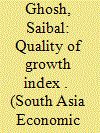| Srl | Item |
| 1 |
ID:
076910


|
|
|
|
|
| Publication |
2007.
|
| Summary/Abstract |
Based on economic growth theory and the World Bank's analytical framework relating to the quality of growth, the present paper constructs a framework that encompasses physical, international, human, natural and knowledge capital to synthetically interpret economic development. After defining the five types of capital and total capital, we analyze the dynamic changes of these types of capital in China and in other countries. The results show that since China's reform and opening up, knowledge, international, human and physical capital have grown rapidly, with speeds of growth higher than that of economic growth. As the five types of capital have all increased at varying paces, the savings level of total capital in China has quadrupled in 25 years and overtook that of the USA in the 1990s. The changes in the five types of capital and total capital reveal that there are progressively multiple driving forces behind China's rapid economic development. Implications for China's long-term economic development are thereby raised
|
|
|
|
|
|
|
|
|
|
|
|
|
|
|
|
| 2 |
ID:
143532


|
|
|
|
|
| Summary/Abstract |
Employing decadal data for the period 1971–2011, this article constructs a quality of growth index (QGI) for major Indian states. The index encompasses not only growth and its durability, but also encompasses several relevant social dimensions. These include variables such as stability and diversification of growth as well as institutional quality and social indicators such as life expectancy and literacy rate. The extended period chosen enables us to trace the evolution of the index over a sufficiently long period of time. Several findings stand out. First, the average value of the index is higher in the post-reform period, suggesting that there has been an overall improvement in the quality of growth over time. However, although the BIMAROU states have raised their QGI, they have still lagged behind their peers. Second, it is typically the industrialized states which have witnessed higher QGI. And third, the industrialized states, with improved financial access and better physical infrastructure, which are better placed are those with higher QGI.
|
|
|
|
|
|
|
|
|
|
|
|
|
|
|
|